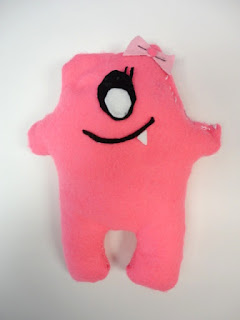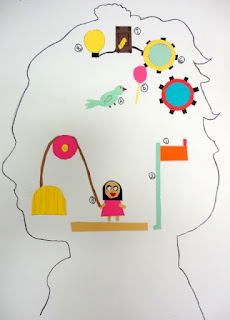Other bloggers are the best. I really enjoy the fact that there are so many of us that are so willing to take the extra time necessary to share all of the cool things we do in our classrooms. I've found that I closely identify with some bloggers. One in particular is Hope Knight from Mrs. Knight's Smartest Artists. I came across this project earlier this school year and had to borrow it. It's just too cool. It's not the first I've borrowed from Mrs. Knight this year!
The project is based on the work of the French painter Auguste Herbin. I hadn't ever heard of him prior to seeing Mrs. Knight's post. He is most famous for his abstract geometric paintings. He used something that he called "Alphabet Plastique," in some of his work. It is almost like a secret code imbedded in his work!
Students started by picking out a couple of words to use as the title of their work. They gave each letter they used a simple geometric design. They then used their code letters to create the final artwork. We talked a lot about composition and design to make sure the final project was arranged in a cool way.
I'm not going to post the lesson plan here because it really isn't mine to post. You can see more details over at Mrs. Knight's blog. I really liked how the artwork came out for this project. I was really bummed that I didn't do this until after the art show. It would have been a beautiful addition to the show. It's definitely on my list for next year.
Tuesday, June 30, 2015
Tuesday, June 23, 2015
5th Grade Plush Monsters & Tiki Mugs
Time flies when you're teaching 5th grade. Between having longer projects in general, having a student teacher, massive amounts of springtime testing, and random end of the year interruptions, we wound up not having time for both of these projects this year. I was forced to make a decision. Do I try to do a shortened version of both? Do I just choose one? Do I teach both at once?!? Yeah, I did that last one. It's surprisingly doable.
My 5th grade classes were split about 50/50 about which project they wanted to do. I've been trying to incorporate more choice into my classroom, so this was a good opportunity.
It couldn't have gone more smoothly. It just worked out that the days I needed to demonstrate major steps on clay, kids on the sewing project were able to work more independently. I was really happy with the outcome for both projects. I really didn't feel stretched too much at all.
Download my Tiki Mug lesson plan!
My 5th grade classes were split about 50/50 about which project they wanted to do. I've been trying to incorporate more choice into my classroom, so this was a good opportunity.
It couldn't have gone more smoothly. It just worked out that the days I needed to demonstrate major steps on clay, kids on the sewing project were able to work more independently. I was really happy with the outcome for both projects. I really didn't feel stretched too much at all.
Download my Tiki Mug lesson plan!
Tuesday, June 16, 2015
3rd Grade Machine Brains
Think about the game of Mousetrap. Do you actually know how to play it? NOBODY DOES. It's a fact that not a single child in the history of kids has ever played Mousetrap by the rules. You build the whole trap and play with it until you get it just right. When you get bored, you get a snack and move on to another activity.
This lesson takes the essence of Mousetrap and turns it into a sweet art project. The entire project is based on the cartoon drawings of Rube Goldberg. If you're not familiar with him, he was a cartoonist who is most famous for his sequential "machines" that were created to intentionally make a simple action incredibly complex.
My students are tasked with coming up with Rube Goldberg style machine that controls something that happens in their head. Think of things like seeing, hearing, burping, etc. In addition to the Rube Goldberg inspiration, students also study the six simple machines and incorporate at least four of them into their work.
The machines that students create are incredibly inventive. I laugh out loud at some of the hilarious sequential steps that they create. The final work is about 95% construction paper- a great way to use up old scraps.
 |
| This is the artist statement that goes along with the artwork above it. |
Tuesday, June 9, 2015
2015 5th Grade Stop Motion Animation Shorts
Stop motion animation is a yearly favorite for 5th grade. This year's collection of 16 short films was posted on YouTube last week.
I let students have a lot of freedom with this project. They split into four groups per class and are in charge of creating the entire film. They are responsible for brainstorming, writing, creating backgrounds/sets, creating characters, animating, video editing, and adding voices. It's a pretty extensive list of things to do and the project tends to drag out for a while.
I'm thinking of changing it around quite a bit for next year. I love the creativity involved, but I don't love how long the project takes and the fact that some groups just don't work well together- especially for a longer amount of time.
My 4th grade classes didn't wind up having time for flip books this year. Right now, I'm looking at probably combining flip books with the stop motion project. I'm going to still use groups, but the groups will create a longer traditional style animation instead of stop motion. I'm still kicking around theme ideas, but I'm really excited to try something new. Until then, enjoy the video from this year. It's hosted on YouTube, so it may not work on school computers for some of you.
Download my lesson plan here!
Monday, June 1, 2015
4th Grade Comic Book Covers
Never fear. 4th Grade superheroes are here! I hosted a student teacher earlier this school year and he was really into comics. He invested a lot of himself in this lesson and it was the best lesson he wrote.
Students started by brainstorming ideas for their superheroes (or villains). They then got to practice some heroic figure drawing using their classmates as models. This really helped students understand proportions better. They then went on to create their final comic book cover using a title and logo for the character. The final work was painted with watercolor. These turned out very nice.
Students started by brainstorming ideas for their superheroes (or villains). They then got to practice some heroic figure drawing using their classmates as models. This really helped students understand proportions better. They then went on to create their final comic book cover using a title and logo for the character. The final work was painted with watercolor. These turned out very nice.
Subscribe to:
Comments (Atom)





































